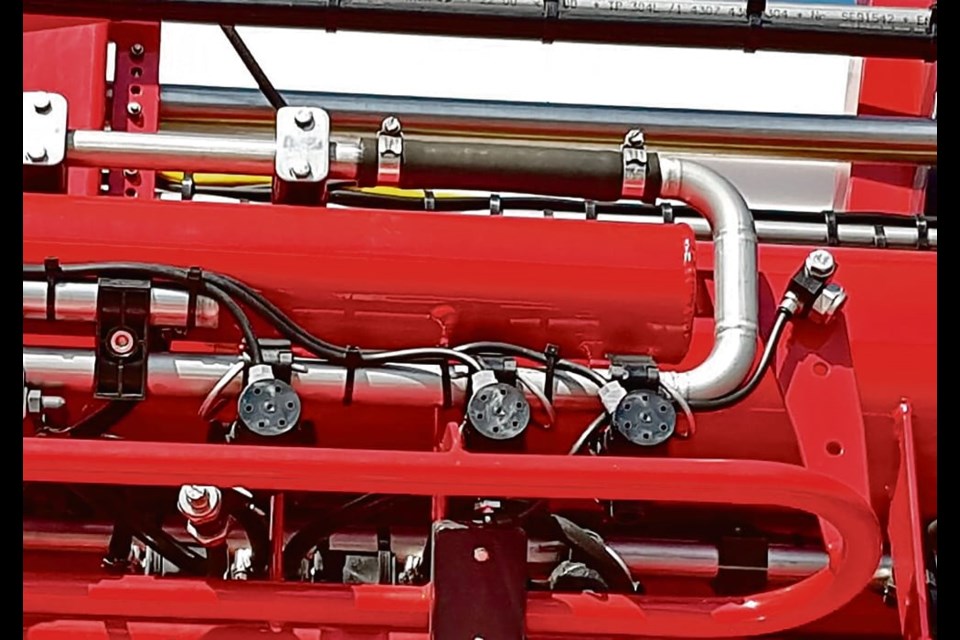WESTERN PRODUCER — Recirculating booms have been around for half a decade, although the concept first came to Western Canada from Pommier about 20 years ago.
Some farmers remain unconvinced they can save time, cut waste and cover more acres per day.
That’s why NozzleGuy Tom Wolf (sprayers101.com) decided recirculating booms should be one of his two presentations at CropConnect 2023. Wolf said some applicators who’ve worked with recirculating booms say they’ll never buy a sprayer without the feature.
He said recirculating booms remove many of the cost, time and contamination problems associated with conventional plumbed sections.
He said the value of spray-free rinsing and priming adds up. Each prime can waste up to 30 gallons on the field before the spray reaches the last nozzle of the longest section. Product can end up soaking into the ground while the sprayer is stationary , possibly close to the same place it might have in previous years.
Recirculating booms simplify the boom priming process, thereby helping prevent soil and water contamination. The design provides an opportunity to install a better sectional control and individual nozzle shut-off valves. Shorter and simpler lengths of plumbing allow stainless steel to be used for return lines, which decreases the potential for pesticide residue being adsorbed.
To rinse a boom with product mix still in the tank, draw water from the on-board clean water tank and push it to the boom without activating any nozzle bodies. The mix in the boom is returned to the tank and replaced with water. Nothing is sprayed or drained. The tank contents may become slightly diluted depending on the duration of the rinse.
To rinse the tank as part of the sprayer cleanout, first spray the tank empty. Then introduce clean water into the product tank via the wash-down nozzles and spray that out. Either use several small batches of clean water or a continuous rinse system to dilute the balance.
Compared to conventional plumbing, there may be additional volume to dilute from the return lines. That depends on the specific recirculating system. Because there are no boom ends, the recirculating system saves effort and ensures a more thorough rinsing.
To prime a boom that contains water, open the return lines back to the tank and allow the new mix to flow through the boom. Some dilution of the tank will occur due to the water in the boom, but nothing is sprayed on the ground.
The necessary powered individual nozzle shutoff does add some cost in a recirculating system. However, the opportunity to improve sectional control via virtual sections is significant. Most monitors offer 16 virtual sections that can be configured. Well-configured virtual sections save costs by reducing spray overlaps.
Any liquid that enters a conventional system must exit at the nozzle or the boom end. It must be sprayed out or drained. This poses three distinct problems that complicate cleaning; it creates waste and contamination, and takes time.
If the boom contains water or a previous spray mix, it needs to be primed with the new product before spraying. The existing product must be sprayed out or drained.
- To clean the boom or flush it with water, it requires the existing liquid be pushed out.
- If there are dead spots in the boom section, such as a boom end, those must be flushed as well.
In a recirculating boom, the spray mixture enters the boom at one end and exits at the other, returning to the spray tank. In most cases, the left and right wing each has its own feed and return. Sectional control is achieved via individual air or electric valves placed on the nozzle bodies.
The first system routes the pressurized mixture into the boom and shuts off the return line during spraying. This is the Pommier system, built in Indiana. When nozzles are shut off for a turn, the return line opens automatically and the boom flow is pushed past the nozzles back to the tank. When the nozzles spray again, the return line closes to pressurize the boom. With this system, the liquid in the spray boom is always moving, preventing settling out of materials.
The second type of system is used by Agrifac and Horsch. It contains a three-way valve connected to the return line and the pressure side of the pump. This valve provides the option of allowing the return line to go back to the tank, or allow pumped flow to the return side so the boom is pressurized at both ends.
This is useful on long booms experiencing pressure drop or when high flows are required. A similar system is available from Rogator in their C-Series featuring LiquidLogic. It has also been used on the Connect sprayer, developed by Pattison Liquid Systems for the D.O.T. autonomous platform.
The main advantages of this design are that it provides the option of additional pressure to the spray boom to avoid pressure drop and to allow any spray mix in the return line to be pushed and sprayed out to the boom for rinsing in the field. This lowers the remaining volume that needs to be diluted.
John Deere’s recirculating boom also has a product reclaim feature. By pushing air through the sprayer lines, product reclaim pushes the solution out of the boom and back into the centre feed tank without needing a liquid flush. With no spraying or draining, there is less contamination risk.

